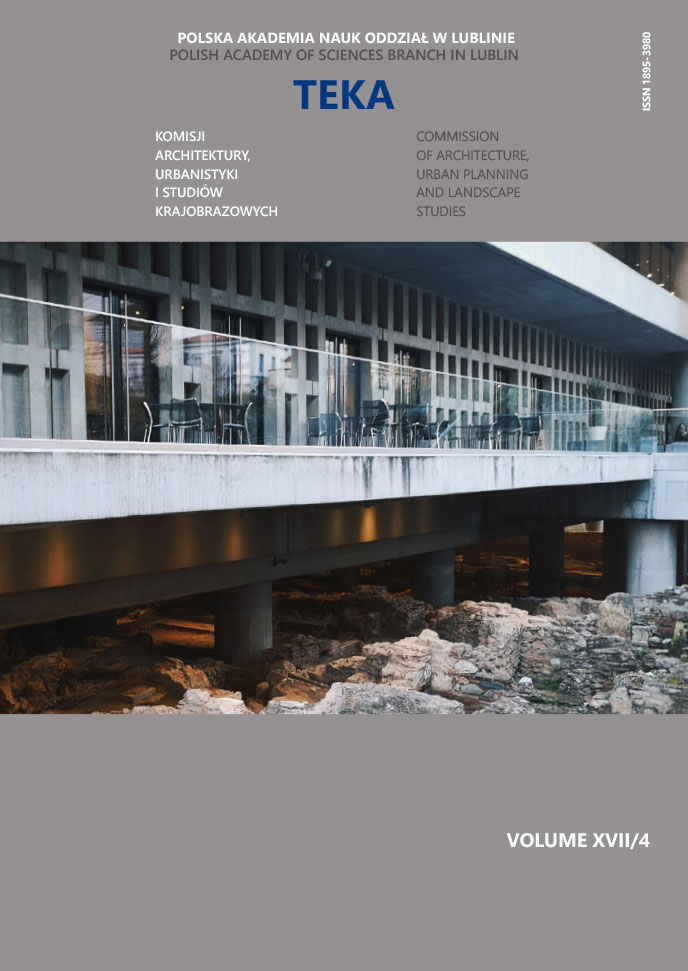Quality assessment of past thermal upgrading projects and an attempt to classify characteristic problems using two-level thermography
Article Sidebar
Open full text
Issue Vol. 17 No. 4 (2021)
-
Tourist accommodation of castles and palaces located within the Lower Silesian Voivodeship
Agnieszka Adamska7-18
-
Painting in the exhibition space, interactions
Joanna Stefańska19-24
-
Fort Bema (P-Parysów) in Warsaw – adaptation to the city recreation function
Piotr Gleń, Cezary Głuszek25-32
-
Phenomenon of the Work of Architect and Visual Artist Włodzimierz Ściegienny
Emilia Malec-Zięba33-49
-
Architectural education according to the didactic thought of Professor Bolesław Szmidt
Wojciech Jabłoński50-56
-
Evaluation of remote learning at technical universities during a pandemic – the perspectives for the future
Dariusz Gaweł57-63
-
Budownictwo z opoki wapnistej na terenie Lubelszczyzny
Katarzyna Drobek, Maciej Trochonowicz64-73
-
Large shopping centres in Poznań as a source of rainwater recovery and irrigation of urban green areas
Paweł Piotr Szumigała, Piotr Urbański, Karolina Olenia Szumigała74-81
-
Quality assessment of past thermal upgrading projects and an attempt to classify characteristic problems using two-level thermography
Anna Ostańska82-91
-
Definiowanie barier w przestrzeniach publicznych
Katarzyna Szmygin99-109
-
The truth of contemporary architecture and aesthetics categories
Andrzej Tokajuk110-116
Archives
-
Vol. 19 No. 2
2023-12-29 11
-
Vol. 19 No. 1
2023-12-19 13
-
Vol. 18 No. 4
2022-12-30 5
-
Vol. 18 No. 3
2022-12-27 5
-
Vol. 18 No. 2
2022-12-27 5
-
Vol. 18 No. 1
2022-12-27 4
-
Vol. 17 No. 4
2021-12-30 11
-
Vol. 17 No. 3
2021-12-30 9
-
Vol. 17 No. 2
2021-12-30 8
-
Vol. 17 No. 1
2021-12-30 8
-
Vol. 16 No. 4
2020-12-30 11
-
Vol. 16 No. 3
2020-09-30 10
-
Vol. 16 No. 2
2020-06-30 11
-
Vol. 16 No. 1
2020-03-31 10
-
Vol. 15 No. 4
2019-12-30 6
-
Vol. 15 No. 3
2019-10-31 9
-
Vol. 15 No. 2
2019-06-28 12
-
Vol. 15 No. 1
2019-03-29 13
Main Article Content
DOI
Authors
Abstract
Two-stage thermography was used in this study. This means that thermograms in the first stage of thermographic research were made using air transport (helicopter tour of the housing estate). Then, after selecting thermally leaking buildings, in the second stage of thermographic research observations were made from the ground level (round and inspection of buildings elements selected in the first stage).
The aim of infrared investigations, successively carried out from 2006 to 2020, was the current assessment of the quality of thermal insulation of multifamily buildings using a non-destructive method and an attempt to determine the necessary repair recommendations, which are aimed at elimination of the remaining or newly formed thermal leaks in the building shell and sustainable operation of the multifamily building.
The article presents the results of thermographic tests and proposes three ways of analysis (preliminary, quality and statistical).
Keywords:
References
Ostańska A.E., Propozycja metody oceny diagnostycznej w podczerwieni termomodernizowanych budynków wielorodzinnych, Builder, 2021, Open Access Journals, XXV.290/9/2021, s. 35−37. DOI:10.5604/01.3001.0015.1939. DOI: https://doi.org/10.5604/01.3001.0015.1939
Zyga J., Ocena budownictwa wielkopłytowego przez pryzmat rynku nieruchomości, Budownictwo i Architektura, 2014, vol. 13, nr 3, s. 57−64.
Nowogońska B., Magdalena Mielczarek, Renovation management method in neglected buildings, Sustainability (Switzerland), 2021, 13 (2), 929. DOI: 10.3390/su13020929. DOI: https://doi.org/10.3390/su13020929
Nowogońska B., A methodology for determining the rehabilitation needs of buildings, Applied Sciences (Switzerland), 2020, 10 (11), 3873, DOI:10.3390/app10113873. DOI: https://doi.org/10.3390/app10113873
Ostańska A., Programowanie rewitalizacji osiedli mieszkaniowych z zastosowaniem modelu PEARS, Polska Akademia Nauk, Lublin 2018, s. 169. ISBN 978-83-939534-4-8.
Ostańska A., Wielka płyta: analiza skuteczności podwyższania efektywności energetycznej: termomodernizacja, termografia, wytyczne naprawcze, PWN, Warszawa 2016, s. 221, ISBN 978-83-01-18512-1.
Moga L., Soimosan T., Environmental and Human Impact of Buildings An Energetics Perspective, An Energetics Perspective. January, 2021, DOI:10.1007/978-3-030-57418-5, ISBN: 978-3-030-57417-8. DOI: https://doi.org/10.1007/978-3-030-57418-5
Dz.U. 2002 nr 75 poz. 690 Rozporządzenie Ministra Infrastruktury z dnia 12 kwietnia 2002 r. w sprawie warunków technicznych, jakim powinny odpowiadać budynki i ich usytuowanie.
Dz.U. 2020 poz. 2351 Rozporządzenie Ministra Rozwoju, Pracy i Technologii z dnia 21 grudnia 2020 r. zmieniające rozporządzenie w sprawie warunków technicznych, jakim powinny odpowiadać budynki i ich usytuowanie.
Ostańska A., Badania wybranych obszarów w Lublinie z uwzględnieniem typoszeregów budynków, Teka Komisji Architektury, Urbanistyki i Studiów Krajobrazowych – Polska Akademia Nauk. Oddział w Lublinie, 2020, vol. 16, nr 3, s. 58−65. DOI: https://doi.org/10.35784/teka.2445
Nowak H., Zastosowanie badań termowizyjnych w budownictwie, Oficyna Wydawnicza Politechniki Wrocławskiej, Wrocław 2012, s. 1−332.
Wróbel Al., Wróbel A., Kontrola termograficzna izolacyjności cieplnej nowo wzniesionych budynków mieszkalnych – cz. I, Inżynier Budownictwa, 2011, nr 2 i 3, s. 55−60.
Kisielewicz T., Wpływ izolacyjnych, dynamicznych i spektralnych właściwości przegród na bilans cieplny budynków energooszczędnych, Wydawnictwo Politechniki Krakowskiej, Kraków 2008, ISSN serii: 0860-097X.
Ostańska A., Increasing the energy efficiency of dwelling houses: case study of residential quarter in Upper Silesia, Poland, Budownictwo i Architektura, 2019, Vol. 18, nr 1. DOI: 10.24358/Bud-Arch_19_181_03. DOI: https://doi.org/10.24358/Bud-Arch_19_181_03
Stachniewicz R., Kontrola sprawności wentylacji przy użyciu termowizj., Materiały Budowlane, 2019, nr 1. DOI: 10.15199/33.2019.01.06. DOI: https://doi.org/10.15199/33.2019.01.06
Kędzierski P., Szumski M., Zastosowanie termografii do oceny jakości energetycznej budynków, Ciepłownictwo, Ogrzewnictwo, Wentylacja, 2019, T. 50, nr 4. DOI 10.15199/9.2019.4.3. DOI: https://doi.org/10.15199/9.2019.4.3
Życzyńska A., Majerek D., Suchorab Z., Żelazna A., Koči V., Černý R., Improving the Energy Performance of Public Buildings Equipped with Individual Gas Boilers Due to Thermal Retrofitting, in: MDPI, Energies, 2021, 14 (6), 1565; doi.org/10.3390/en14061565. DOI: https://doi.org/10.3390/en14061565
Tommy Y. Lo, K.T.W. Choi, Building defects diagnosis by infrared thermography, Structural Survey, 2004, 22 (5). DOI: 10.1108/02630800410571571. DOI: https://doi.org/10.1108/02630800410571571
Grinzato E., Vavilov V., Kauppinen T., Quantitative infrared thermography in buldings, Energy and Buildings, 1998, nr 29: 1−9. DOI: https://doi.org/10.1016/S0378-7788(97)00039-X
Ostańska A.E., Propozycja synergicznego zarządzania i oszczędzania energii w osiedlu mieszkaniowym opartej na opinii mieszkańców – przykład Lublina, Teka Komisji Architektury, Urbanistyki i Studiów Krajobrazowych – Polska Akademia Nauk. Oddział w Lublinie, 2021, vol. 17, nr 1, s. 68−78. DOI: https://doi.org/10.35784/teka.2669
Article Details
Abstract views: 294
License

This work is licensed under a Creative Commons Attribution-ShareAlike 4.0 International License.


